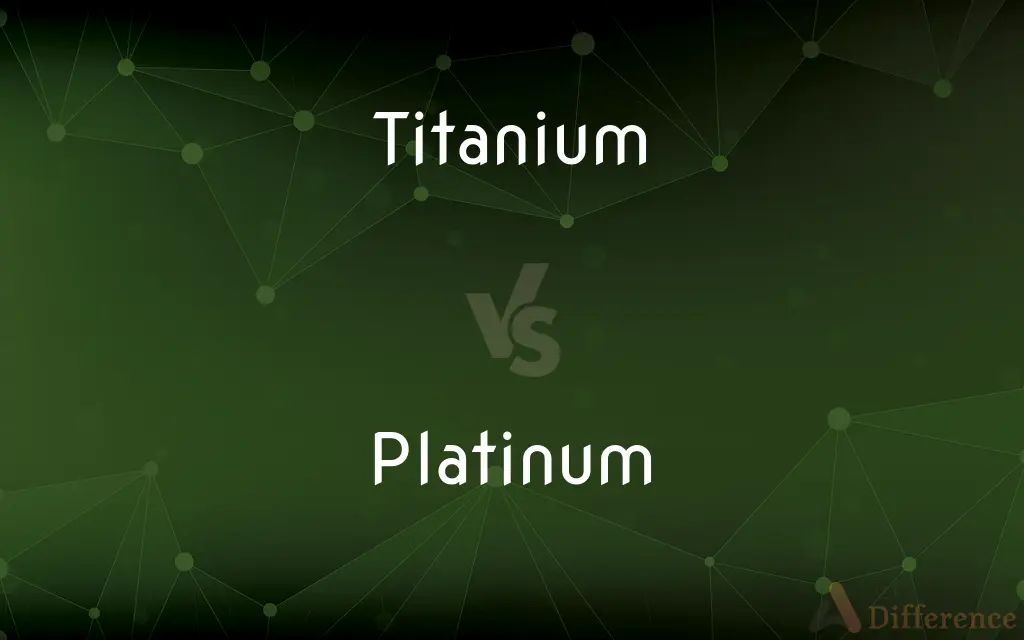Titanium vs. Platinum — What's the Difference?
By Fiza Rafique & Urooj Arif — Updated on April 29, 2024
Titanium is a strong, lightweight metal used primarily in aerospace and medical industries, while platinum is a dense, precious metal valued highly in jewelry and industrial applications.

Difference Between Titanium and Platinum
Table of Contents
ADVERTISEMENT
Key Differences
Titanium is known for its high strength-to-weight ratio, making it ideal for applications where both durability and lightness are critical, such as in aerospace structures and sporting goods. On the other hand, platinum is heavier and more malleable, favored in jewelry for its ability to hold gemstones securely and in industrial catalysts due to its chemical stability.
Titanium is less dense than many metals, contributing to its utility in areas where weight is a constraint, like in the manufacture of aircraft and prosthetics. Whereas platinum’s high density and resistance to wear make it suitable for high-end jewelry that can withstand frequent handling.
The corrosion resistance of titanium is exceptional, enabling its use in environments that are corrosive to most other metals, including sea water and chlorinated water environments. Conversely, platinum is inert, making it hypoallergenic and suitable for medical implants and dental fillings.
Titanium is generally more affordable and abundant compared to platinum. This makes titanium a more accessible material for various industrial and consumer products, whereas the rarity and labor-intensive refining process of platinum contribute to its higher cost.
Titanium does not tarnish and remains silver-gray in color, which is a significant aesthetic feature for its use in jewelry and decorative items. Platinum, however, is naturally white and maintains its color and luster indefinitely, making it particularly valued in fine jewelry.
ADVERTISEMENT
Comparison Chart
Density
Lower, about 4.5 g/cm³
Higher, about 21.45 g/cm³
Main Uses
Aerospace, medical implants
Jewelry, industrial catalysts
Corrosion Resistance
High, resistant in many environments
Very high, chemically inert
Cost
Generally lower
Generally higher
Aesthetic
Silver-gray, does not tarnish
Naturally white, maintains luster
Compare with Definitions
Titanium
A strong, lightweight metal known for its corrosion resistance and biocompatibility.
Titanium is often used for surgical implants because it is accepted by the human body.
Platinum
A dense, precious metal that is highly resistant to wear and tarnish.
Platinum rings are popular for engagement and wedding bands because they do not fade or tarnish.
Titanium
Used in alloys to enhance strength without adding much weight.
Titanium alloys are crucial in modern aerospace design.
Platinum
Used in catalytic converters in automobiles to reduce harmful emissions.
Platinum plays a critical role in environmental technology for cars.
Titanium
Commonly found in consumer goods such as watches and golf clubs.
Titanium watches are prized for their durability and lightness.
Platinum
Popular in investment and bullion coins.
Investors often buy platinum coins as a secure investment.
Titanium
The element with atomic number 22, symbol Ti.
Titanium is as strong as steel but much lighter.
Platinum
Valued in the medical field for use in pacemakers and chemotherapy drugs.
Platinum-based drugs are used in the treatment of certain types of cancer.
Titanium
Also used in architectural applications for its longevity and modern aesthetic.
Titanium panels are used in buildings for their weather resistance and unique sheen.
Platinum
The element with atomic number 78, symbol Pt.
Platinum is more precious than gold in many markets.
Titanium
Titanium is a chemical element with the symbol Ti and atomic number 22. Its atomic weight is 47.867 measured in daltons.
Platinum
Platinum is a chemical element with the symbol Pt and atomic number 78. It is a dense, malleable, ductile, highly unreactive, precious, silverish-white transition metal.
Titanium
A strong, low-density, highly corrosion-resistant, lustrous white metallic element that occurs widely in igneous rocks and is used to alloy aircraft metals for low weight, strength, and high-temperature stability. Atomic number 22; atomic weight 47.87; melting point 1,668°C; boiling point 3,287°C; specific gravity 4.51; valence 2, 3, 4. See Periodic Table.
Platinum
A trademark for a certification indicating that a recording, such as an album of music, has sold a million copies.
Titanium
A chemical element, atomic number 22; it is a strong, corrosion-resistant transition metal, used to make light alloys for aircraft etc.
Platinum
Symbol Pt A silver-white metallic element occurring in alluvial deposits in sperrylite and nickel ores, usually mixed with other metals such as iridium, osmium, or nickel. It is ductile and malleable, does not oxidize in air, and is used as a catalyst and in electrical components, jewelry, dentistry, and electroplating. Atomic number 78; atomic weight 195.08; melting point 1,768.2°C; boiling point 3,825°C; specific gravity 21.45 (20°C); valence 2, 3, 4. See Periodic Table.
Titanium
(countable) A single atom of this element.
Platinum
A medium to light gray.
Titanium
An elementary substance found combined in the minerals manaccanite, rutile, sphene, etc., and isolated as an infusible iron-gray amorphous powder, having a metallic luster. It burns when heated in the air. Symbol Ti. Atomic weight 48.1.
Platinum
The chemical element with atomic number 78 and symbol Pt; a dense, malleable, ductile, highly unreactive, silverish-white transition metal of great value.
Titanium
A light strong gray lustrous corrosion-resistant metallic element used in strong light-weight alloys (as for airplane parts); the main sources are rutile and ilmenite
Platinum
A whitish grey colour, like that of the metal.
Platinum
(music) A single or album that has achieved platinum sales, i.e. over 1 million or 2 million.
Platinum
A platinum-based drug: a platin#Etymology 2.
Platinum
Of a whitish grey colour, like that of the metal.
Platinum
Of a musical recording that has sold over one million copies (for singles), or two million (for albums).
Platinum
Very expensive, or of very high quality
We can offer the platinum service for fifty dollars extra.
Platinum
(computer games) to reach platinum level in a game
I platinumed in Clash of Clans yesterday.
Platinum
A metallic element of atomic number 78, one of the noble metals, classed with silver and gold as a precious metal, occurring native or alloyed with other metals and also as the platinum arsenide (sperrylite). It is a heavy tin-white metal which is ductile and malleable, but very infusible (melting point 1772° C), and characterized by its resistance to strong chemical reagents. It is used for crucibles in laboratory operations, as a catalyst, in jewelry, for stills for sulphuric acid, rarely for coin, and in the form of foil and wire for many purposes. Specific gravity 21.5. Atomic weight 195.1. Symbol Pt. Formerly called platina.
Platinum
A heavy precious metallic element; gray-white and resistant to corroding; occurs in some nickel and copper ores and is also found native in some deposits
Common Curiosities
Can titanium be used in jewelry just like platinum?
Yes, titanium is used in jewelry, especially for its hypoallergenic properties and modern look.
Why is titanium preferred in aerospace applications?
Its high strength-to-weight ratio makes it ideal for reducing weight while maintaining structural integrity.
Which metal is more durable?
Both metals are durable, but platinum is more wear-resistant, making it ideal for jewelry that endures daily use.
What are the main properties that differentiate titanium from platinum?
Titanium is lightweight and strong with high corrosion resistance, while platinum is dense, malleable, and maintains luster.
What makes platinum valuable in jewelry?
Its rarity, luster, and ability to hold gemstones securely make it a preferred choice for fine jewelry.
What role does titanium play in consumer electronics?
Titanium is used in electronic devices for its robustness and lightweight properties.
Is platinum a good investment metal?
Yes, due to its rarity and stable demand in both jewelry and industrial applications, platinum is considered a good investment.
What are the industrial uses of both metals?
Titanium is widely used in aerospace and medical industries, while platinum is used in automotive catalytic converters and electronics.
How is the jewelry market impacted by the choice between titanium and platinum?
The choice affects the style, weight, and price point of jewelry pieces.
What is the cost comparison between titanium and platinum?
Platinum is significantly more expensive than titanium due to its rarity and the complexity of its refining process.
How does the weight of titanium compare to platinum?
Titanium is much lighter, making it preferable in applications where weight is a limiting factor.
How do environmental properties affect the usage of titanium vs. platinum?
Titanium’s corrosion resistance allows it to be used in marine and chlorinated environments, unlike most metals.
Are there any common misconceptions about titanium and platinum?
A common misconception is that both metals are equally heavy; in reality, titanium is much lighter.
Why is platinum used in medical implants?
Its inert nature and hypoallergenic properties make it suitable for long-term implantation in the human body.
What are the recycling practices for titanium and platinum?
Both metals are highly recyclable, but platinum’s high value ensures almost all scrap is reprocessed.
Share Your Discovery

Previous Comparison
Overcorrection vs. Hypercorrection
Next Comparison
Whiteprint vs. BlueprintAuthor Spotlight
Written by
Fiza RafiqueFiza Rafique is a skilled content writer at AskDifference.com, where she meticulously refines and enhances written pieces. Drawing from her vast editorial expertise, Fiza ensures clarity, accuracy, and precision in every article. Passionate about language, she continually seeks to elevate the quality of content for readers worldwide.
Co-written by
Urooj ArifUrooj is a skilled content writer at Ask Difference, known for her exceptional ability to simplify complex topics into engaging and informative content. With a passion for research and a flair for clear, concise writing, she consistently delivers articles that resonate with our diverse audience.
















































